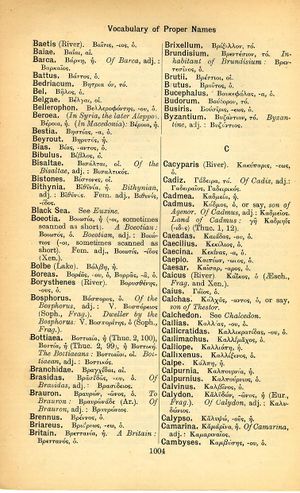Calliope: Difference between revisions
σοὶ μὲν παιδιὰν τοῦτ' εἶναι, ἐμοὶ δὲ θάνατον → This is sport to you but death to me (Aristotle, Eudemian Ethics 1243a20)
m (Text replacement - "link={{" to "link={{") |
m (Text replacement - "}}]]" to "}}]]") |
||
| Line 1: | Line 1: | ||
{{WoodhouseENELnames | {{WoodhouseENELnames | ||
|Text=[[File:woodhouse_1004.jpg|thumb | |Text=[[File:woodhouse_1004.jpg|thumb | ||
|link={{filepath:woodhouse_1004.jpg | |link={{filepath:woodhouse_1004.jpg}}]][[Καλλιόπη]], ἡ. | ||
}} | }} | ||
{{Lewis | {{Lewis | ||
Revision as of 10:10, 15 August 2017
English > Greek (Woodhouse)
Καλλιόπη, ἡ.
Latin > English (Lewis & Short)
Callĭŏpē: ēs (Callĭŏpēa, ae, Verg. E. 4, 57; Prop. 1, 2, 28; Ov. F. 5, 80; cf. Prisc. p. 563 P.), f., = Καλλιόπη and Καλλιόπεια (fine-voiced),
I the chief of the Muses, goddess of Epic poetry, and, in the poets, sometimes of every other kind of poetry (e.g. the lyric, Hor. C. 3, 4, 1 sqq.; of amatory poetry, Ov. Tr. 2, 568; of rural poetry, Col. 10, 225; cf. Jahn, Trist. p. 198); the mother of Orpheus by Œagrus, Hyg. Fab. 14; acc. to Serv. ad Verg. A. 5, 864, the mother of the Sirens by Acheloüs; Lucr. 6, 94; cf. Prop. 2, 1, 3; Ov. M. 5, 339; Aus. Idyll. 20, 7; Anthol. Lat. I. p. 73, 9; Mart. 4, 31, 8. To her Hor. C. 3, 4, is addressed.—
II Meton.
A (Per syllepsin.) All the Muses, Verg. A. 9, 525.—
B (Per synecdochen.) Poetry, Ov. Tr. 2, 568.— Hence, Callĭŏpēĭus, a, um, adj., = Καλλιοπήϊος, of Calliope: puer, i. e. Hymenaeus, Anthol. Lat. VI. p. 89, 77: musici, Firm. Math. 7, 25.
Latin > French (Gaffiot 2016)
Callĭŏpē,¹² ēs f., Calliope [muse de l’éloquence et de la poésie héroïque] : Lucr. 6, 94 ; Hor. O. 3, 4, 2 ; [muse en gén., poésie] Virg. En. 9, 523 ; Ov. Tr. 2, 1, 568 || -pēa, æ, f., Virg. B. 4, 57 || -ēĭus, a, um, Anth. 941, 77 et -ĭcus, a, um, Firm. Math. 7, 25, de Calliope.
Latin > German (Georges)
Calliopē, ēs, f. (Καλλιόπη, die Schönstimmige), eine der neun Musen, Göttin der epischen, aber bei Dichtern zuweilen auch jeder andern Dichtung, mit Schreibtafel und Griffel dargestellt, I) eig., Lucr. 6, 94. Hor. carm. 3, 4, 2: mit den übrigen Musen, Auson. app. IV (de musis), 9. p. 251 Schenkl. Anthol. Lat. 88, 9 (616, 9): neben Melpomene u. Polyhymnia, Mart. 4, 31, 8. – Nbf. Calliopa, ae, f., Arnob. 5, 26 (wo Calliopae filius). – II) meton.: A) für sämtliche Musen, Verg. Aen. 9, 525. – B) = Dichtung, Ov. trist. 2, 568. – / Nbf. Calliopēa, ae, f. (Καλλιόπεια), Verg. ecl. 4, 57 u.a. Dichter. – Dav. Calliopēius, a, um (Καλλιοπήϊος), kalliopëisch, der Kalliope, puer, v. Hymenäus, Anthol. Lat. 6, 941, 77 (283, 77): musici, Firm. math. 7, 25.

